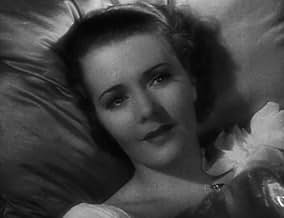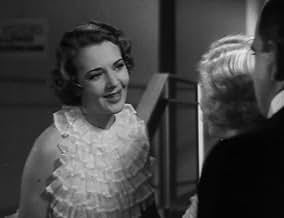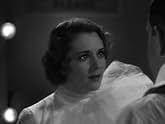Broadway star Al Howard's unreliability gets him blacklisted. His sister pairs him with Dorothy for a Chicago club. He borrows from gangsters for his own Broadway club, juggling Dorothy, mob... Read allBroadway star Al Howard's unreliability gets him blacklisted. His sister pairs him with Dorothy for a Chicago club. He borrows from gangsters for his own Broadway club, juggling Dorothy, mob money, and gangster's girlfriend Luana.Broadway star Al Howard's unreliability gets him blacklisted. His sister pairs him with Dorothy for a Chicago club. He borrows from gangsters for his own Broadway club, juggling Dorothy, mob money, and gangster's girlfriend Luana.
- Nominated for 1 Oscar
- 1 win & 1 nomination total
- Duke Hutchinson
- (as Barton Mac Lane)
- Nellie Lahey (Blonde Showgirl)
- (as Sharon Lynne)
- Tom McGee
- (as William Davidson)
- Herman Lahey
- (uncredited)
- Wardrobe Mistress
- (uncredited)
- Young Woman in Elevator
- (uncredited)
- Angry Showgirl #1
- (uncredited)
Featured reviews
Opening title: "BROADWAY: The street of ups and downs, where show business in 1935 was in top speed." Story: Al Howard (Al Jolson), is an irresponsible and egotistic entertainer responsible for his Broadway shows closing by not appearing. Al's sister, Molly (Glenda Farrell) comes to the Actors Equity Association with the assurance that this will be Al's last time that he will ever desert a show, but she is told by the producers that he is through on Broadway. Molly manages to get her old friend, Dorothy Wayne (Ruby Keeler), a dancer, to team up with Al in hope her partnership with him will lead up to his comeback. Dorothy agrees and she and Al become successful for the next several months appearing at Brown's St. Ledger Roof Garden. While Al treats Dorothy like a "kid," and philanders with other women, especially chorus girls, Dorothy, who resents being treated this way, unwittingly falls in love with Al and decides to leave the act. Molly, however, persuades Dorothy to remain and soon arranges to hire Duke Hutchinson (Barton MacLane), an underworld financier, to back Al's new night club engagement, The Casino De Paree, in New York. In the meantime, Al, who considers himself "God's gift to women," becomes entangled with Luana Wells (Helen Morgan), a blues singer who happens to be Duke's wife wanting to also make a comeback on Broadway by appearing at the Casino De Paree. Before opening night, Al is told by Dorothy, after receiving a phone call, that his sister Molly is in jail for murder. Al must decide whether to take the show's $30,000 to bail out Molly, or go on with the show as planned. If he abandons this show, the Duke will have his thugs awaiting for him outside.
Patsy Kelly, not mentioned in the above synopsis, provides true comedy relief in appearing in three separate scenes with Jolson actually unrelated to the plot as if she were added in at the last minute to boost up some comedy. In spite all, it helps the continuity along. Kelly is a laugh riot and not to be missed. Glenda Farrell, featured as Jolson's sister, known best for usually playing a wisecracking and fast-talking gold-digger, gets her chance on film to play a basically straight character. Farrell only has one scene that does involve comedy which takes place on a train where she encounters a British passenger (Arthur Treacher) after accidentally dipping him with ink. She even gets her chance to wear stylish wardrobes and fur coat.
Great tunes by Harry Warren and Al Dubin include: "Cielito Lindo" (written by Elpidio Ramirez and sung in Spanish by Jolson); "A Good Old-Fashioned Cocktail" (sung/danced by Ruby Keeler and chorus); "Mammy, I'll Sing About You" (Jolson); "About a Quarter to Nine," "Swanee River" (by Stephen Foster, sung briefly by Jolson in black-face); "The Little Things You Used to Do" (sung by Helen Morgan); "Casino De Paree," "She's a Latin From Manhattan," "Go Into Your Dance" and a reprise finish to "About a Quarter to Nine" (all sung by Jolson). During a night club sequence earlier in the story, there is an underscoring by a band to the tune, "'Cause My Baby Says It's So," but is never sung in the story. Possibly an intended song for this movie but scrapped before release. That song would finally be heard and fully introduced by Dick Powell in "The Singing Marine" (Warners, 1937).
Also in the cast are Akim Tamiroff, Sharon Lynn, Phil Regan and Gordon Westcott. While Benny Rubin gets screen credit, he has only a tiny bit at The Caliente. I did recognize former silent screen actress, Mary Carr, famous for sentimental mother roles in the twenties, briefly scene as a wardrobe woman.
"Go Into Your Dance," available on DVD and occasional viewing on Turner Classic Movies, is 89 minutes of solid entertainment, highly recommended as it is entertaining. And as Jolson would say whenever being truthful and sincere, "A word of a Howard." (***1/2)
"Go Into Your Dance" is a highly flawed movie and the main character, Al (Al Jolson), is an oddly written guy--and it makes you wonder WHAT the writer was thinking! After all, he plays a successful Broadway star (what a stretch!) who is a jerk. Again and again, when he has a successful show he gets bored and simply walks away...leaving everyone in a lurch. This makes his character a seriously bad person...leaving backers and actors to be ruined simply because he gets bored! Well, by the time this film starts, he's once again disappeared and is down in Mexico having a good time...and he's burned about every possible bridge. So, when he has an idea about putting on a new show, backers are naturally unexcited about it. And this gets me to the HUGE problem with the film...the audience watching this picture also feels the same way---Al is a jerk and you DON'T want to see him succeed. Why would Jolson agree to make this film as it makes him look awful...just as terrible as the guy Ruby Keeler used to say he was like off stage!?
What you get in this film is pretty much what you'd expect otherwise. Jolson sings a lot and there are a lot of production numbers. And, unfortunately, Al gets the break he simply doesn't deserve. But what does he do with it? See the film.
I noticed that I am one of the few reviewers who thought the movie was fatally flawed. Obviously the other viewers could look past Al's nasty history of ditching shows because he got bored. They also apparently could look past Jolson doing a black-face number-- something he was famous for over the course of his career. As for me, the film was a decent time-passer and no more. It did end well and got better as the film progressed. I also noticed that a lot of the actors yelled their lines--particularly Barton MacLane and Ruby Keeler. Oddly, Patsy Kelly didn't!
What Go Into Your Dance really was meant to do is try to save the Jolsons marriage which was in free fall by then. Al's egomania didn't make him the easiest person to live with and within a few years Keeler called it quits. For the rest of her life she would never answer one question about life with Jolson.
Warner Brothers did assemble a good cast for them. Al plays an irresponsible, egomaniacal entertainer, no stretch in the casting department. He's walked out on too many a show as his sister Glenda Farrell tells him, no producer will hire him. Never mind says Jolie, he'll produce his own with a new dancer he's discovered, Ruby Keeler.
Producing costs money and that means going to gangster Barton MacLane whose trampy wife wants to resume her show business career. Jolie gets the money and the wife played by Helen Morgan. But his problems are only beginning.
Bobby Connolly did the dance direction and I have to say pinch hit admirably for Busby Berkeley. The big hit song of the film was Jolson singing and Keeler dancing to About a Quarter to Nine. It was nicely staged and worthy of Berkeley in every sense of the word as Berkeley gave Jolson that awful Going' to Heaven on a Mule in Wonder Bar. In this film the chorus of male dancers and Jolson all turn to blackface for a minute. Jolson also does the finale title song in blackface as well.
Unfortunately not only does Jolson do blackface, but in this film, not once, but twice he rubs the head of black actor Fred "Snowflake" Toone for good luck. That particular bit of tastelessness kept Go Into Your Dance off the television screens for decades. I remember seeing it on WOR TV's million dollar movie as a lad in the Fifties, but never again until recently.
The real pity is that we were also deprived of seeing Helen Morgan sing as well. Her alcoholism had gotten pretty bad at this point, but she was one of Broadway brightest stars. She sings The Little Things You Used to Do in her typical poignant fashion. It would have really been great to see her co-star with Jolson in a film, but that was not to be.
Go Into Your Dance is quite a museum piece of a film and if you're not into Jolson, I would urge you to see it for Helen Morgan.
Did you know
- TriviaThis was the only film that Al Jolson and Ruby Keeler made together during their 12-year marriage, which lasted from 1928 to 1940.
- Quotes
Dorothy Wayne: Well, I finally met your brother.
Molly Howard, aka Lucille Thompson: Yeah, where is he?
Dorothy Wayne: Flat on his back, out cold, back of the Shim Sham.
Molly Howard, aka Lucille Thompson: What happened to him?
Dorothy Wayne: Well, man meets girl, girl meets husband, husband meets man, man meets sidewalk.
- Crazy creditsOpening card: Broadway..The street of ups and downs, where show business in 1935 was at top speed.
- ConnectionsEdited into Musical Memories (1946)
- SoundtracksGo Into Your Dance
(1935) (uncredited)
Music by Harry Warren
Lyrics by Al Dubin
Played during the opening credits
Played during a rehearsal and sung by Al Jolson
Also performed by Al Jolson at the Casino De Paree at the end
- How long is Go Into Your Dance?Powered by Alexa
Details
- Release date
- Country of origin
- Language
- Also known as
- Casino de Paree
- Filming locations
- Union Station - 1050 Kettner Boulevard, San Diego, California, USA(exterior establishing shot of the Santa Fe Depot)
- Production company
- See more company credits at IMDbPro
Box office
- Budget
- $703,000 (estimated)
- Runtime
- 1h 29m(89 min)
- Color
- Sound mix
- Aspect ratio
- 1.37 : 1


























